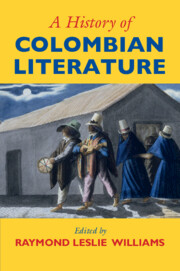Book contents
- Frontmatter
- Contents
- Notes on contributors
- Preface
- Introduction
- PART I LITERATURE AND SOCIETY IN COLOMBIA
- 1 Colonial realities and colonial literature in “Colombia”
- 2 Cosmography, ethnography, and the literary imagination of the New Kingdom of Granada
- 3 Colombian poetry from the colonial period to Modernismo (1500–1920)
- 4 Reflections on the historiography of the Colombian novel: 1844–1953 and beyond
- 5 Modern Colombian poetry: from modernismo to the twenty-first century
- 6 The late twentieth-century Colombian novel (1970–1999)
- 7 Twenty-first century fiction
- 8 Colombian theater: staging the sociopolitical body
- 9 The Colombian essay
- PART II COLOMBIAN CULTURE AND SOCIETY IN REGIONAL CONTEXTS
- PART III BEYOND THE BOUNDARIES
- AFTERWORDS
- Index
- References
9 - The Colombian essay
from PART I - LITERATURE AND SOCIETY IN COLOMBIA
Published online by Cambridge University Press: 05 June 2016
- Frontmatter
- Contents
- Notes on contributors
- Preface
- Introduction
- PART I LITERATURE AND SOCIETY IN COLOMBIA
- 1 Colonial realities and colonial literature in “Colombia”
- 2 Cosmography, ethnography, and the literary imagination of the New Kingdom of Granada
- 3 Colombian poetry from the colonial period to Modernismo (1500–1920)
- 4 Reflections on the historiography of the Colombian novel: 1844–1953 and beyond
- 5 Modern Colombian poetry: from modernismo to the twenty-first century
- 6 The late twentieth-century Colombian novel (1970–1999)
- 7 Twenty-first century fiction
- 8 Colombian theater: staging the sociopolitical body
- 9 The Colombian essay
- PART II COLOMBIAN CULTURE AND SOCIETY IN REGIONAL CONTEXTS
- PART III BEYOND THE BOUNDARIES
- AFTERWORDS
- Index
- References
Summary
In Colombia, essays and essayism are the norm, rather than the exception. Etymologically, an essay is an attempt or try at conveying something; essayism its accompanying exploratory ethos. There is a rich corpus of Colombian writing along those lines. Instead of understanding the essay as autonomous genre, it is by appreciating it within the fold of essayism – in its most unbridled, protean dimension – that one may begin to appreciate its relevance and sheer potency in the Colombian context. At the same time, because the essay is everywhere, it is also nowhere. Dispersion of cultural capital and repetition are constant risks in the literature, as authors appear to be more adept at generating essayism than at building upon the exploits of their forerunners. The present chapter, by no means exhaustive, offers an account of this process and some of the signposts necessary to navigate its sprawling terrain.
Montaigne (1533–92), often credited as the father of the essay, puts forward an adaptive exercise in judgment. He compares himself to a man who tests the waters and sees where they make take him:
I take the first subject that chance offers. … Scattering a word here, there another, samples separated from their context, dispersed, without a plan and without a promise, I am not bound to make something of them or to adhere to them myself without varying when I please and giving myself up to doubt and uncertainty and my ruling quality, which is ignorance.(219, qtd. in Gómez-Martínez 18)
Colombian essayism often displays many of the same traits, namely: self-irony, ludic tone, false modesty, style-driven persuasiveness, and supple reasoning. Many of its proponents present a happy combination of improvisation and judgment that, as in their early modern counterparts, desacralize and question. Others get the worse of this combination, leading to idiosyncrasy and thinly argued ex cathedra pronouncements.
A counterpart to the treatise in a country where treatises are seldom written, the Colombian essay must play multiple roles. With the notable exception of Héctor Orjuela, most accounts of the form start with the nation itself. The critic traces its origins back to Sumario de la natural historia de las Indias (1526, Summary of the Natural History of the Indies) by Gonzalo Fernández de Oviedo (1478–1557) and to El antijovio (The Anti-Jovius) by Gonzalo Jiménez de Quesada (1506–79), founder of Bogotá.
- Type
- Chapter
- Information
- A History of Colombian Literature , pp. 198 - 212Publisher: Cambridge University PressPrint publication year: 2016

